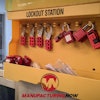RABAT, Morocco (AP) -- It was no coincidence that Morocco was chosen as the destination for the first intercontinental flight by a solar-powered aircraft, the pilot said early Wednesday after stepping out of the fragile craft following a 20-hour flight from Madrid.
Bertrand Piccard told reporters and government officials who came to meet him at the runway of the Rabat airport in the middle of the night that it was Morocco's ambitious solar energy plans that brought him here.
"We came here out of admiration for Morocco's pioneering solar energy program," he said, flashing a brilliant smile and hugging members of his team on the tarmac.
Just moments earlier, the Solar Impulse had swept silently out of the darkness to glide onto the runway. Its four battery-powered turbo-props were already still, showing off the aircraft's ability to fly even when the sun is gone.
"It was perhaps the most beautiful flight of my life. I have dreamed since I was a child of flying without using fuel," said Piccard, who hails from a family of adventurers and who already has circumnavigated the world by balloon.
Solar Impulse is a single-seat aircraft fitted with 12,000 solar cells across a wingspan similar to that of a large commercial jet airliner. But it weighs roughly as much as an average family car, according to organizers.
In November 2009, Morocco announced a plan to build five solar energy plants with a capacity of 2,000 megawatts by 2020. Construction on the first plant in Ouarzazate on the edge of the Sahara is expected to start this month.
The winner of the bid for the project will be announced in days, said Mustafa Bakkouri, the head of Morocco's new solar energy agency. That will coincide with a flight by the Solar Impulse from Rabat to the site of the future plant.
Morocco, whose primary source of energy is oil it has to import, hopes to eventually export its solar energy to Europe.
Solar Impulse arrived in Madrid from Switzerland in late May on the first leg of its journey, but the delicate craft was delayed for several days by bad weather before it could continue its journey to Morocco. The two-leg Europe to Africa trip covered 2,500 kilometers (1,554 miles).
The light craft can fly only in perfect weather. The plane has managed to climb to 28,000 feet (8,535 meters) and reached top speeds of more than 75 mph (120 kph), though its usual cruising speed is just over half that.
Piccard said the plane isn't meant to eventually replace conventional air travel, but rather to demonstrate what is possible with solar energy. "All of the technology on this plane can be used in daily life," he said.
The mission is being described as a final dress rehearsal for a round-the-world flight with a new and improved plane in 2014 involving five stops.
The project began in 2003 and is estimated to have cost about $100 million. It is supported by several major corporations, including Deutsche Bank, Bayer and Schindler.






















